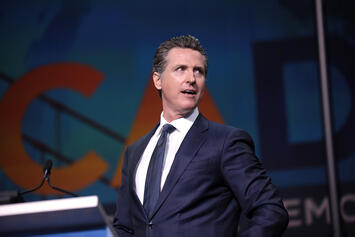
Conservatives often see prospective presidential contender Gavin Newsom as a tool of the far Left—and, as such, politically doomed by the seemingly endless crises afflicting California. Yet the Golden State governor is a more formidable candidate than this portrayal suggests. Rather than being a progressive windup doll, the 54-year-old is in fact a skilled political opportunist, with far less dogmatically left-wing views than most of his party’s legislative delegation. He would have no qualms abandoning unpopular progressive stances to pursue the goal of succeeding a doddering President Joe Biden.
In just the last week, Newsom provided two indicators of his flexibility. He vetoed a bill that would have legalized “shooting alleys”—so-called safe drug-injection sites—in San Francisco, Los Angeles, and Oakland. Many of his progressive allies, who favor such programs, denounced the veto. They may be untroubled by rising street crime and drug overdoses, but Newsom knows that disorder in California’s major cities offers a devastating talking point for his opponents—especially those to his right.
Even more striking was Newsom’s recent turnaround on California’s last nuclear plant, and even its gas plants. The green constituency in California detests both forms of energy production and even seeks to ban gas stations, gas heaters, and anything else tainted by fossil fuels. California’s green policies have helped make its energy prices among the nation’s highest and have created conditions likely to cause massive energy shortages on the power grid. Large-scale blackouts and brownouts could also become fodder for anti-Newsom political ads in 2024.
Newsom’s recent moves on public safety and energy have outraged California progressives, particularly the powerful green lobby, which denounced his energy move as “incredibly dangerous.” (California’s greenhouse-gas emissions are statistically meaningless next to those of China, which emits more carbon than all other industrial countries combined.) Newsom knows that green pronunciamentos about the distant future—for example, the recently announced ban on the sale of new gas cars after 2035, and the goal (set in 2018 by his predecessor) of relying on a zero-carbon electric grid in 2045—make better politics than trying to shut down an economy that still depends on fossil fuels today. Newsom spokesman Anthony York suggested that the alternative policies proposed by greens “feels like fantasy and fairy dust.”
Yet none of Newsom’s recent moves should be surprising. He is, after all, not the product of the radical social-justice crowd but the anointed candidate of the Bay Area’s uber class. He generally backs causes embraced by Silicon Valley and the heirs of inherited wealth—on gay marriage, gender, abortion, gun control, and climate change—rather than those focused on expropriating the wealth of the tech, entertainment, and financial elites who have financed his career.
Indeed, compared with Jerry Brown, his far more interesting and sometimes more intellectually driven predecessor, Newsom tends to bend with changing conditions. As mayor of San Francisco, he ran as a “dogmatic fiscal conservative and a social liberal,” who moved ahead of the pack on issues like gay marriage but also proved friendly to the tech firms that transformed the city during his reign. After winning election as lieutenant governor, in 2011, Newsom ventured to Texas to witness firsthand that state’s thriving economy—a move many saw as implicit criticism of then-Governor Brown.
As he eyes a White House campaign, in the event Biden doesn’t seek reelection, Newsom faces some homegrown obstacles, including the presence of his fellow Californian, Vice President Kamala Harris, in the Biden administration. But Harris generates little enthusiasm these days, even among California progressives, and many expect her to be bought off by a plum private-sector job or perhaps an appointment to the Supreme Court. Yet even if Harris leaves on demand, Newsom will still have to cope with the negatives associated with his patrician profile.
Read the rest of this piece at City Journal.
Joel Kotkin is the author of The Coming of Neo-Feudalism: A Warning to the Global Middle Class. He is the Roger Hobbs Presidential Fellow in Urban Futures at Chapman University and Executive Director for Urban Reform Institute. Learn more at joelkotkin.com and follow him on Twitter @joelkotkin.
Photo: Gage Skidmore via Flickr under under CC 2.0 License.













doddering?, please
Have you seen Dark Brandon lately?
Dave Barnes
+1.303.096.2264